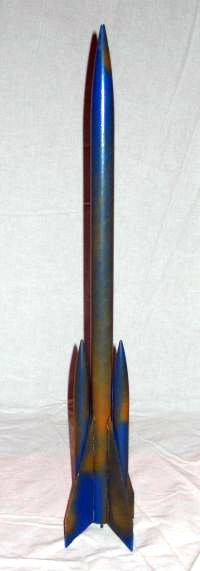| Construction Rating: | starstarstarstar_borderstar_border |
| Flight Rating: | starstar_borderstar_borderstar_borderstar_border |
| Overall Rating: | starstarstarstar_borderstar_border |
| Diameter: | 0.98 inches |
| Manufacturer: | Estes  |
| Skill Level: | 2 |
| Style: | Sport |

Brief:
The Estes Gemini DC is dual parachute, lawn dart ready single stage rocket with
two side pods housing the chutes. It uses a 1/8 inch launch lug and has a
single 18mm motor mount. The Gemini DC has four swept back balsa fins.
Construction:
The components used in this rocket are top quality. The parts list is:
- 1 BT-50 main body tube, slotted with vent holes
- 1 two-piece NC-50 nose cone
- 2 BT-20 side pods with vent holes
- 2 NC-20 nose cones
- 2 50-20 centering rings
- 1 18mm motor mount tube
- 1 mylar ring
- 1 engine hook
- 1 1/8 inch launch lug
- 1 1/4 inch vent tube
- 2 rubber shock cords
- 2 12 inch parachutes
- 4 balsa fins
The instructions were very easy to follow and all the parts fit together easily. The main body tube had four slots with two holes perpendicular to each other in between two of the fin slots. The first step was to make the standard Estes motor mount, which is slitting the motor mount tube, putting on the hook, sliding on the mylar ring, and then attaching the centering rings. This assembly slides into the back of the rocket so the end of the motor tube is even with the aft end of the body tube. Next, all four fins were glued in and fillets were added. Then, a template was used to find launch lug position and to make the lines to glue on the side pods. The only fit problem was with the vent tubes. This required the cutting of an Estes 1/4 inch launch lug for venting the gasses of the motor's ejection charge to the side pods. The vent tube is a little too wide to fit through the hole, so they required some sanding. Once I thought the glue dried, I put some glue on the side and slid the vent into the hole in the side pod. The glue wasn't dry, so the vent was pushed slightly into the main body. This happened on both sides. Then, I glued in all of the nose cones and attached the shock cords to the inside of the side pods. The parachutes were then tied to the end of the shock cords.
Finishing:
I didn't use any special finishing techniques, just prime and paint. I painted
mine blue and sprayed orange over it so the blue is visible through the orange.
Construction Rating: 3 out of 5
Flight:
I have not had one successful flight with this rocket. I have flown it on twice
on B4-4s and once on a C6-5. All three flights went straight and fast with a
sudden jump off the pad.
Recovery:
The boost and coast phases were great, but the recovery is horrible. Sometimes
the ejection gasses bypassed both chutes and sometimes only one chute comes out
but doesn't open because it was wrapped up so tightly to fit inside the tube.
Both situations caused the rocket to lawn dart. My favorite flight was when the
ejection charge blew the main nose cone off and what a surprise! It lawn darted
and core sampled.
Flight Rating: 1 out of 5
Summary:
This is not a good rocket. The parts are good quality but make sure the chutes
are nice and loose and that the nose cones are glued in securely. There is a
very small chance of a successful recovery.
Overall Rating: 3 out of 5
Other Reviews
- Estes Gemini DC By George Pluck (July 8, 2013)
The Estes Gemini DC features twin 'chute deployment from the rear of two attached side pods. Though much maligned, it's a very cool kit Components Three tubes, one main and two for the side pods Balsa fins mount through the main tube Plastic nose cones My kit came with an extra engine clip as well as the usual Estes components. ...
- Estes Gemini DC By Tai Fu
Dual rear deployment parachute. The construction is good, because it has TTW fins, which means it is stronger than the other ones, also you don't have to worry about the fin alignment because the slot has done that for you. You just need to make sure that air can flow freely to the 2 parachute pods otherwise this rocket will lawn dart!!! You can always forget about the parachute pod and ...
- Estes Gemini DC By Mike Goss
I had often looked at this kit and wondered how those twin parachutes would work. I found out one day when a friend launched his and had only one chute deployed. The recovery was a little hard on the rocket and broke one of the pods off the side of the rocket. Reading the other reviews, I have learned that this is the rule and not the exception for this rocket. I determined that my rocket would ...
 |
 |
Flights
 |
 |